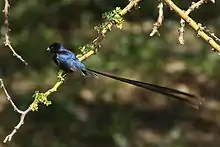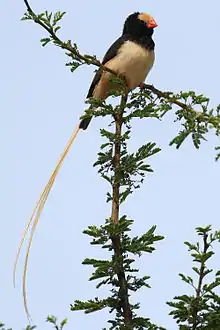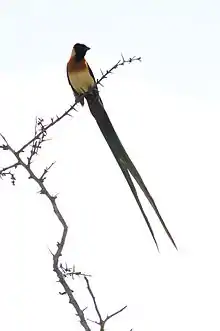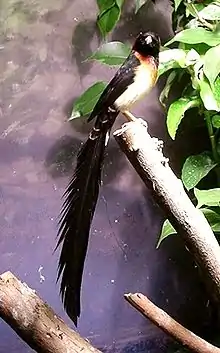Vidua
Vidua is a genus of passerine birds in the family Viduidae.
| Vidua | |
|---|---|
_breeding_male.jpg.webp) | |
| Male pin-tailed whydah (Vidua macroura) | |
| Scientific classification | |
| Kingdom: | Animalia |
| Phylum: | Chordata |
| Class: | Aves |
| Order: | Passeriformes |
| Family: | Viduidae |
| Genus: | Vidua Cuvier, 1816 |
| Species | |
|
see text | |
The genus was introduced by the French naturalist Georges Cuvier in 1816.[1] The type species was subsequently designated as the pin-tailed whydah.[2] The name Vidua is the Latin word for "widow".[3]
The genus contains 19 species:[4]
| Image | Scientific name | Common Name | Distribution |
|---|---|---|---|
_(17849716130).jpg.webp) | Vidua chalybeata | Village indigobird | Africa south of the Sahara Desert. |
.jpg.webp) | Vidua purpurascens | Purple indigobird | Angola, Botswana, Democratic Republic of the Congo, Kenya, Malawi, Mozambique, South Africa, Tanzania, Zambia, and Zimbabwe. |
| Vidua raricola | Jambandu indigobird | Benin, Burkina Faso, Cameroon, Central African Republic, Ghana, Guinea, Ivory Coast, Liberia, Nigeria, Sierra Leone, South Sudan and Togo. | |
| Vidua larvaticola | Barka indigobird | Cameroon, Ethiopia, Gambia, Ghana, Guinea, Nigeria, Sudan, and South Sudan. | |
.jpg.webp) | Vidua funerea | Dusky indigobird | Angola, Burundi, Cameroon, Republic of the Congo, Democratic Republic of the Congo, Guinea-Bissau, Malawi, Mozambique, Nigeria, Sierra Leone, South Africa, Swaziland, Tanzania, Zambia, and Zimbabwe |
| Vidua codringtoni | Zambezi indigobird | Malawi, Tanzania, Zambia, and Zimbabwe. | |
| Vidua wilsoni | Wilson's indigobird | Cameroon, Central African Republic, Chad, Republic of the Congo, Democratic Republic of the Congo, Ivory Coast, Ghana, Guinea, Guinea-Bissau, Nigeria, Senegal, South Sudan, and Togo. | |
| Vidua nigeriae | Quailfinch indigobird | The Gambia, Nigeria and Cameroon. | |
| Vidua maryae | Jos Plateau indigobird | Nigeria | |
| Vidua camerunensis | Cameroon indigobird | Sierra Leone to east Cameroon, north east Zaire and South Sudan. | |
 | Vidua macroura | Pin-tailed whydah | Africa south of the Sahara Desert. |
 | Vidua hypocherina | Steel-blue whydah | Ethiopia, Kenya, Somalia, South Sudan, Tanzania, and Uganda. |
 | Vidua fischeri | Straw-tailed whydah | Ethiopia, Kenya, Somalia, South Sudan, Tanzania, and Uganda. |
 | Vidua regia | Shaft-tailed whydah | Southern Africa, from south Angola to south Mozambique |
_(17329851342).jpg.webp) | Vidua paradisaea | Long-tailed paradise whydah | Eastern Africa, from eastern South Sudan to southern Angola |
| Vidua orientalis | Sahel paradise whydah | west Africa | |
 | Vidua interjecta | Exclamatory paradise whydah | Benin, Cameroon, Central African Republic, Chad, Democratic Republic of the Congo, Ethiopia, Ghana, Guinea, Liberia, Mali, Nigeria, Sudan, and Togo. |
| Vidua togoensis | Togo paradise whydah | Benin, Cameroon, Chad, Ivory Coast, Ghana, Mali, Sierra Leone, and Togo. | |
 | Vidua obtusa | Broad-tailed paradise whydah | Angola, Botswana, Burundi, Democratic Republic of the Congo, Kenya, Malawi, Mozambique, Namibia, Rwanda, South Africa, Tanzania, Uganda, Zambia, and Zimbabwe |
References
- Cuvier, Georges (1816). Le Règne animal distribué d'après son organisation : pour servir de base a l'histoire naturelle des animaux et d'introduction a l'anatomie comparée (in French). 1. Paris: Déterville. pp. 388–389.
- Dickinson, E.C.; Christidis, L., eds. (2014). The Howard & Moore Complete Checklist of the Birds of the World. Volume 2: Passerines (4th ed.). Eastbourne, UK: Aves Press. p. 303. ISBN 978-0-9568611-2-2.
- Jobling, J.A. (2018). del Hoyo, J.; Elliott, A.; Sargatal, J.; Christie, D.A.; de Juana, E. (eds.). "Key to Scientific Names in Ornithology". Handbook of the Birds of the World Alive. Lynx Edicions. Retrieved 2 May 2018.
- Gill, Frank; Donsker, David, eds. (2018). "Waxbills, parrotfinches, munias, whydahs, Olive Warbler, accentors, pipits". World Bird List Version 8.1. International Ornithologists' Union. Retrieved 2 May 2018.
This article is issued from Wikipedia. The text is licensed under Creative Commons - Attribution - Sharealike. Additional terms may apply for the media files.